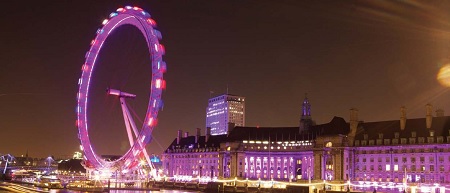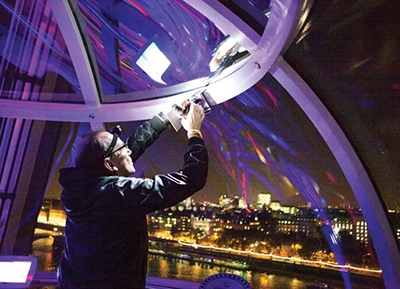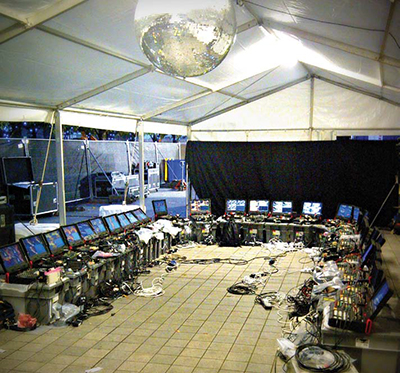London Eye Links Record Number of Streams

LONDON—For one night in November, the huge Ferris wheel that dominates the London skyline played host to the most ambitious and ethereal audio/video streaming event ever attempted. Back in the real world, it could be the last event of its kind for quite awhile.
Red Bull Music Academy teamed with satellite broadcaster SIS Live, Channel4.com, You-Tube and Innovision to produce a rotating array of simultaneous music tributes to Britain’s club culture—accolades that were quite literally “encapsulated” inside the passenger pods of that massive spinning wheel officially dubbed the “EDF Energy London Eye.” SIS Live (Satellite Information Services, Ltd.) likes to say the entire event was “broadcast live” and distributed via online streaming. In fact, technically speaking, neither terrestrial signals nor satellites were used in the making of this extraordinary event… just a whole lot of fiber and special RF allocations.
The 31 “legendary club nights” on Nov. 14 featured more than 100 DJs and artists circling high above London on the banks of the Thames. Even though SIS Live and Red Bull had engaged in slightly less elaborate technological feats in past years, this latest venture still held more than its share of logistical challenges. Especially tricky, multi-camera pod feeds had to be produced from each moving capsule and streamed live in the U.K. on channel4.com and via YouTube internationally. (Channel4.com is the online arm of Channel 4, a public broadcaster that both receives government funding and airs commercials.)

SIS LIVE Special Cameras department Installed 60 miniature cameras in the EDF Energy London Eye for the Nov. 14 event.ROUTECAST IN A BOX
SIS Live first had to develop robust systems to ensure its content’s safe delivery. Thirty-one RouteCase systems were used inside the capsules to produce video/audio feeds which subsequently were transmitted to the temporary production compound located at ground level. Designed and manufactured by SIS Live, RouteCase is a portable HD production studio featuring a 4-input vision mixer and 10-channel audio mixer geared for tight spaces. In addition to the multiple feeds emanating from the moving Ferris wheel’s passenger pods, Channel4.com featured an additional live Webcast captured by two RF cameras in order to mix highlights from the passenger pods, a helicopter cam, and other vantage points.
“The planning and preparation for this event was meticulous, particularly owing to the tight turnaround and intensive RF and IP requirements,” said David Meynell, SIS Live’s managing director. The technical setup, he said, had “the unique ability to deliver complex RF and special camera solutions to produce live coverage from technically demanding events such as this.”
The 31 individual “broadcasts” were encoded on-site by eight servers (installed in SIS Live’s ground-based MPV1 vehicle) and delivered by fiber for online streaming. Since each of the sources was constantly in motion on the big wheel, it was not possible to use fiber to transfer the signals, per se, which meant a comprehensive RF network had to be deployed. Given the current squeeze on suitable RF frequencies available in the U.K., SIS Live said spectrum management firm JFMG and OFCOM (Britain’s FCC) proved helpful in releasing additional bandwidth for the one-night endeavor. Each of the eight servers provided built-in redundancy and incoming-feed monitoring. A 400 MB pipe was used to deliver streams in HD (1080p).
MOVING TARGET
The logistical setup on the largest Ferris wheel in Europe began many months prior to Nov. 14, according to Innovision, a British production agency specializing in large public events, which had assisted Red Bull from the earliest stages.(Per company policy, Red Bull does not comment on its own events.) According to Innovision Technical Director Jaie Genadt, “First, there was the stakeholder management. To get the required permissions to establish [and] install the equipment required to run an event of this nature was a six-month process, though we got there in the end.”
The professional video industry's #1 source for news, trends and product and tech information. Sign up below.

A total of 31 SIS RouteCases were prepped for the live broadcast. The technical challenges on show night were even greater since the London Eye is a popular tourist attraction and closing it down even briefly was not an easy task. Pinpoint logistical planning was crucial to, among other things, ensuring the crew could load everything in the right order as each capsule passed by and briefly stopped at ground level.
“In only two hours we had to install 31 individual sound specs, the lighting, the cameras, and the microwave link setups,” Genadt said. “This operation was planned to the minute with 150 technical crew lined up at 1730 [5:30 p.m.] to gain access to the capsules to set up. They were then joined by the artists to sound check at [6:30] and went live to 1.1 million viewers at [7:30],” Genadt said.
WHAT GOES AROUND…
Meanwhile, SIS Live’s Meynell had said “being central to the delivery of such a high-profile event and working with multiple parties is what SIS Live does best,” although apparently it will be the firm’s last venture of its kind. In late October, prior to the Red Bull event, SIS Live announced it would shutter its Outside Broadcast Division by next Spring. The prime reason for the drastic move: its failure to get its previous BBC sports contracts renewed going forward. An SIS Live spokesman confirmed to TV Technology that the pending “outside” shutdown could affect nearly 250 jobs and place on the sales block its mammoth fleet of 18 HD/SD trucks and auxiliary equipment.
